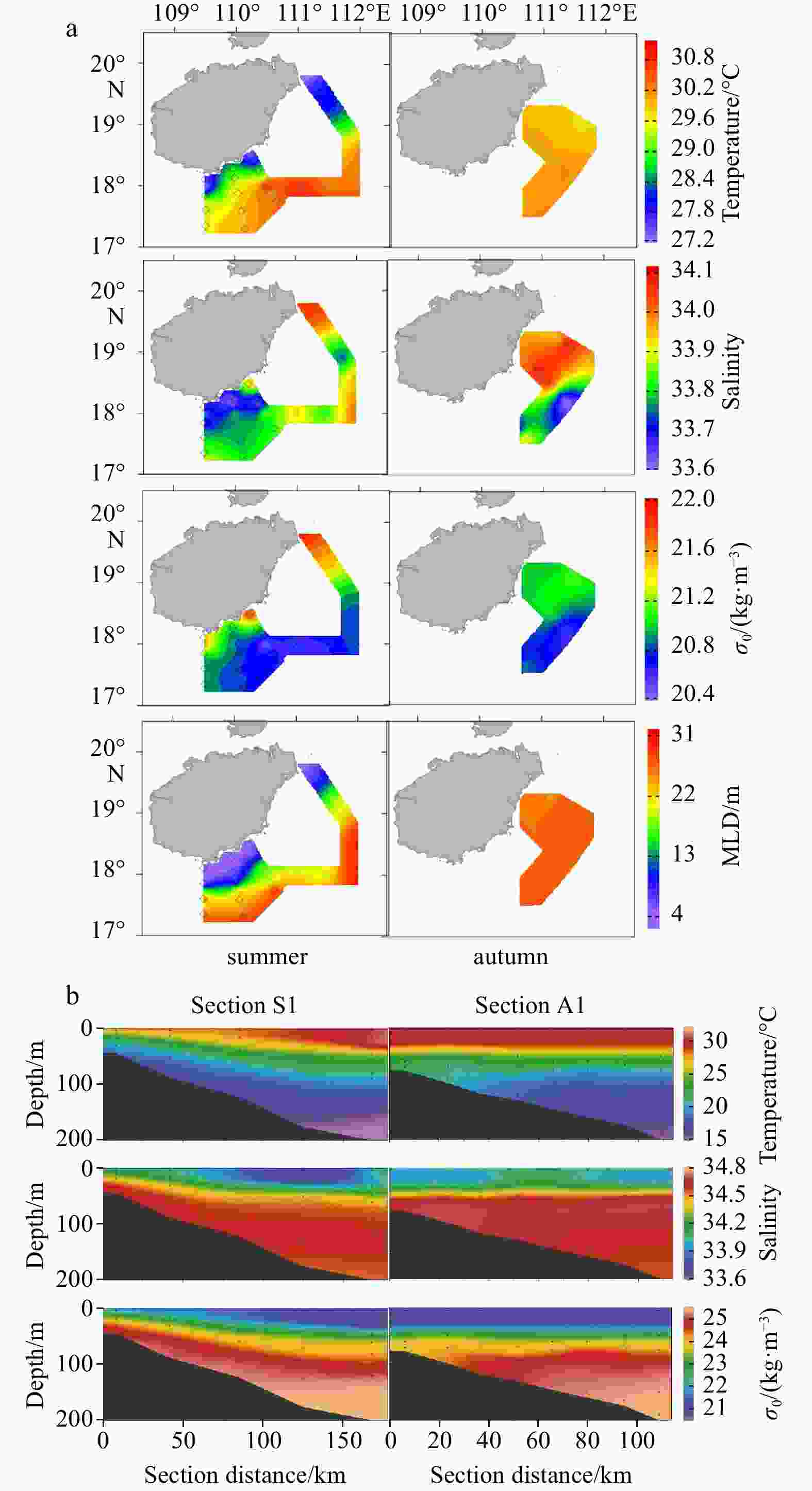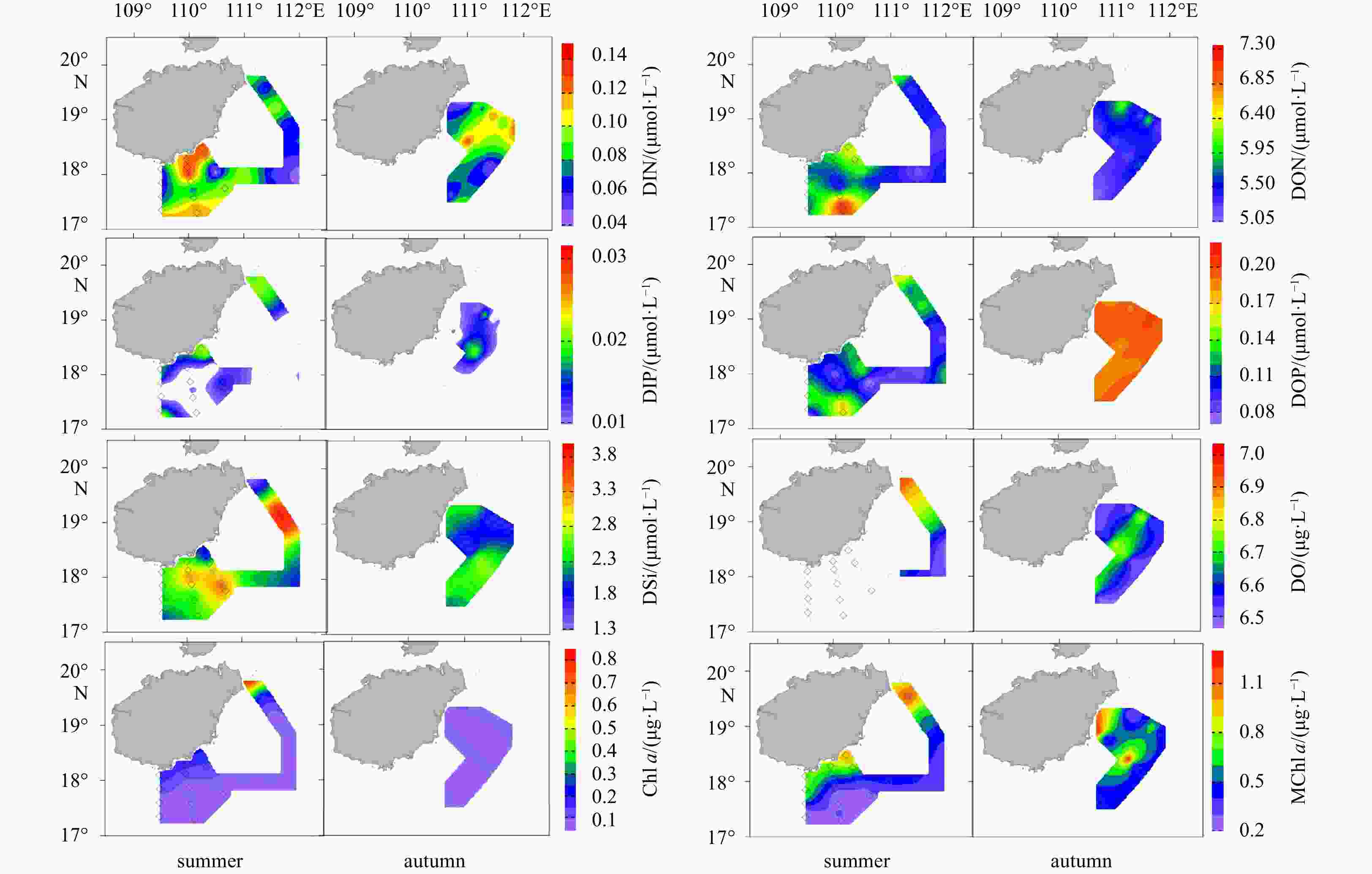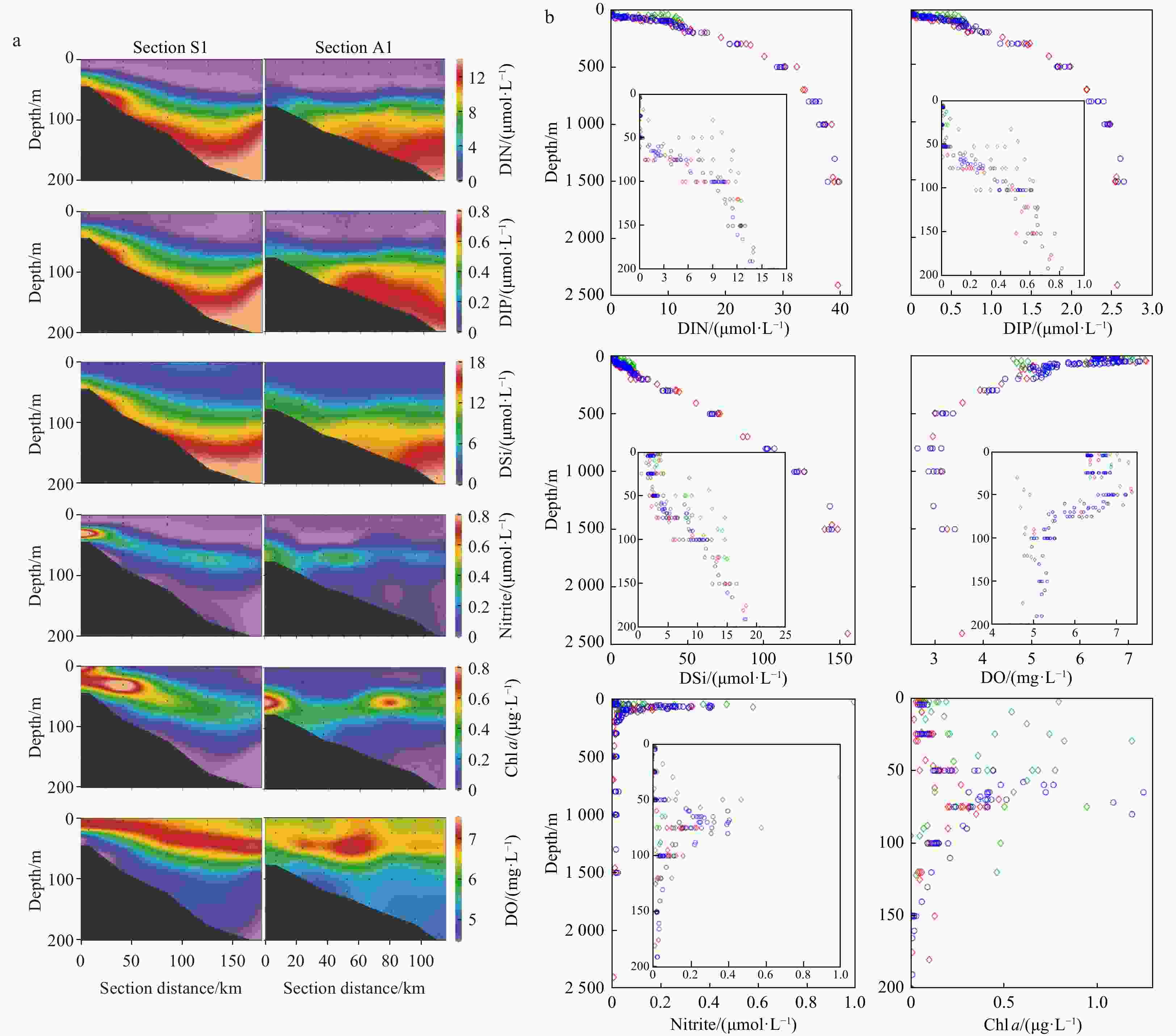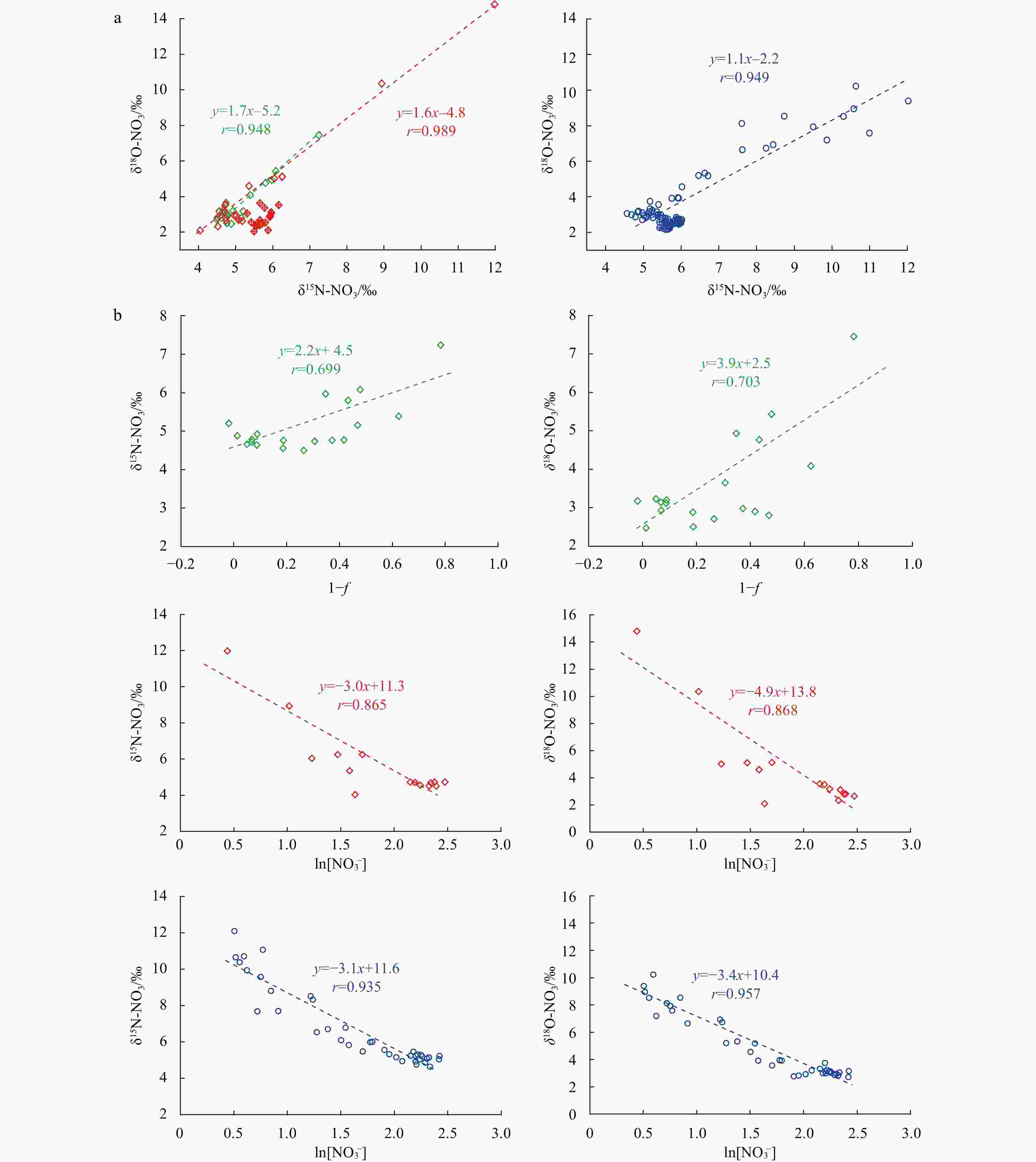Responses of nutrient biogeochemistry and nitrogen cycle to seasonal upwelling in coastal waters of the eastern Hainan Island
-
Abstract: The coastal upwelling has profound influence on the surrounding ecosystem by supplying the nutrient-replete water to the euphotic zone. Nutrient biogeochemistry was investigated in coastal waters of the eastern Hainan Island in summer 2015 and autumn 2016. From perspectives of nutrient dynamics and physical transport, the nutrient fluxes entered the upper 50 m water depth (between the mixed layer and the euphotic zone) arisen from the upwelling were estimated to be 2.5−5.4 mmol/(m2·d), 0.15−0.28 mmol/(m2·d), and 2.2−7.2 mmol/(m2·d) for dissolved inorganic nitrogen (DIN), phosphate (DIP), and dissolved silicate (DSi), respectively, which were around 6- to 12-fold those in the background area. The upwelled nutrients supported an additional plankton growth of (14.70±8.95) mg/m2 for chlorophyll a (Chl a). The distributions of nitrate δ15N and δ18O above the 300 m water depth (top of the North Pacific Intermediate Water) were different among the upwelling area, background area in summer, and the stations in autumn, and the difference of environmental and biogeochemical conditions between seasons should be the reason. The higher DIN/DIP concentration ratio, nitrate concentration anomaly, and lower nitrate isotope anomaly (Δ(15, 18)) in the upper ocean in summer than in autumn indicated the stronger nitrogen fixation and atmospheric deposition, and the following fixed nitrogen regeneration in summer. The higher values of Chl a and nitrate δ15N and δ18O within the euphotic zone in autumn than the background area in summer suggested the stronger nitrate assimilation in autumn. The differences in relatively strength of the assimilation, nitrogen fixation and atmospheric deposition, and the following remineralization and nitrification between the two seasons made the higher δ18O:δ15N and larger difference of enzymatic isotope fractionation factors 15ε and 18ε for nitrate assimilation in summer than in autumn above the North Pacific Tropical Water.
-
Key words:
- nutrients /
- upwelling /
- nitrate δ15N and δ18O /
- nitrogen cycle /
- South China Sea
-
Figure 1. The study area and sampling stations in coastal waters of the eastern Hainan Island in summer 2015 (rhombuses) and autumn 2016 (circles). The biogeochemical sampling stations were colored as blue, and the black ones were only for hydrological sampling. The directions of monsoon (southwest monsoon, SWM; northeast monsoon, NEM) and Guangdong Coastal Current (GCC) during summer and winter were indicated as red and blue arrows, respectively. Four sections in summer and two sections in autumn were marked from northeast to southwest (S1−S4, A1 and A2 colored as red). SCS is the abbreviation of South China Sea; ZJB, Zhanjiang Bay; LP, Leizhou Peninsula; QZS, Qiongzhou Strait; LSB, Lingshui Bay; YLB, Yulin Bay.
Figure 2. Surface distribution of temperature, salinity, potential density anomaly (σ0), and the mixed layer depth (MLD) in coastal waters of the eastern Hainan Island in summer and autumn (a); 200 m water depth sectional distribution of temperature, salinity, and σ0 in Section S1 in summer and Section A1 in autumn (b).
Figure 3. The temperature–salinity diagram showing isopycnals in coastal waters of the eastern Hainan Island in summer and autumn (a); the color indicated the water depth. The inside figures with smaller ranges of potential temperature, salinity, and water depth (0–150 m) show the details. Depth profiles for temperature and potential density anomaly (σ0) (b). Dark blue circles were the samples of autumn. Rhombuses were the samples of summer, and green indicated the stations in the nearshore upwelling region and red stood for the offshore background stations. The inside figures were the same as their outside figures only with the water depth above 200 m to show the details. NPTW is the abbreviation of the North Pacific Tropical Water; NPIW, the North Pacific Intermediate Water.
Figure 4. Surface distribution of nutrients, Chl a, and DO concentrations in coastal waters of the eastern Hainan Island in summer and autumn. Concentration is below the detection limit in the blank area of DIP. We did not get the data of DO in the southern three sections in summer. MChl a: Chl a concentration at the depth of the Chl a maximum layer.
Figure 5. The sectional distribution of biogeochemical parameters in the upper 200 m in Sections S1 in summer and A1 in autumn (a); depth profiles of biogeochemical parameters (b). The shapes and colors distinguished the samples as same as those in Fig. 3b. The inside figures were the same as their outside figures only with the water depth above 200 m to show the details.
Figure 6. Relationships between DIN and DIP as well as DSi and DIN. The shapes and colors distinguished the samples as same as those in Fig. 3b. The solid line was the regression curve for the whole water depth samples, and the dotted line was the regression curve for samples above and below the center of the North Pacific Tropical Water (~150 m). The slope was marked as the k.
Figure 8. The relationships between the nitrate δ18O and δ15N (a); and between δ15N, δ18O, and 1-f; δ15N, δ18O, and ln[
${\rm{NO}}_3^- $ ] (b). The green and red rhombuses, and blue circles stood for the upwelling and background stations in summer, and all stations in autumn above the North Pacific Tropical Water (NPTW). The dotted lines and equations were the linear regressions for samples above the NPTW. The rhombuses and circles with cross inside in a were samples below the NPTW. The slopes in b were regarded as the isotope fractionation factor (ε). The f was the fraction of unassimilated nitrate in the water column.Table 1. Water depth weighted nutrient and Chl a concentrations above 50 m of the upwelling region and its background values, and of stations in autumn in coastal area of the eastern Hainan Island
DIN/(µmol·L−1) DIP/(µmol·L−1) DSi/(µmol·L−1) Chl a/(μg·L−1) DON/(µmol·L−1) DOP/(µmol·L−1) Upwelling average 1.59 0.10 3.88 0.39 5.69 0.13 SD 1.65 0.09 1.23 0.18 0.28 0.02 Background average 0.08 0.01 2.56 0.09 5.67 0.11 SD 0.02 0.01 0.54 0.03 0.25 0.02 Autumn average 0.16 0.01 2.35 0.11 5.62 0.19 SD 0.12 0.01 0.33 0.04 0.54 0.01 -
[1] Albert A, Echevin V, Lévy M, et al. 2010. Impact of nearshore wind stress curl on coastal circulation and primary productivity in the Peru upwelling system. Journal of Geophysical Research: Oceans, 115(C12): C12033. doi: 10.1029/2010JC006569 [2] Altabet M A. 2006. Isotopic tracers of the marine nitrogen cycle: present and past. In: Volkman J K, ed. Marine Organic Matter: Biomarkers, Isotopes and DNA. Berlin: Springer, 251–293 [3] Bombar D, Dippner J W, Doan H N, et al. 2010. Sources of new nitrogen in the Vietnamese upwelling region of the South China Sea. Journal of Geophysical Research: Oceans, 115(C6): C06018 [4] Bourbonnais A, Lehmann M F, Hamme R C, et al. 2013. Nitrate elimination and regeneration as evidenced by dissolved inorganic nitrogen isotopes in Saanich Inlet, a seasonally anoxic fjord. Marine Chemistry, 157: 194–207. doi: 10.1016/j.marchem.2013.09.006 [5] Bourbonnais A, Lehmann M F, Waniek J J, et al. 2009. Nitrate isotope anomalies reflect N2 fixation in the Azores Front region (subtropical NE Atlantic). Journal of Geophysical Research: Oceans, 114(C3): C03003 [6] Buchwald C, Santoro A E, McIlvin M R, et al. 2012. Oxygen isotopic composition of nitrate and nitrite produced by nitrifying cocultures and natural marine assemblages. Limnology and Oceanography, 57(5): 1361–1375. doi: 10.4319/lo.2012.57.5.1361 [7] Cai Pinghe, Zhao Daochen, Wang Lei, et al. 2015. Role of particle stock and phytoplankton community structure in regulating particulate organic carbon export in a large marginal sea. Journal of Geophysical Research: Oceans, 120(3): 2063–2095. doi: 10.1002/2014JC010432 [8] Casciotti K L, Buchwald C, McIlvin M. 2013. Implications of nitrate and nitrite isotopic measurements for the mechanisms of nitrogen cycling in the Peru oxygen deficient zone. Deep-Sea Research Part I: Oceanographic Research Papers, 80: 78–93. doi: 10.1016/j.dsr.2013.05.017 [9] Casciotti K L, Sigman D M, Hastings M G, et al. 2002. Measurement of the oxygen isotopic composition of nitrate in seawater and freshwater using the denitrifier method. Analytical Chemistry, 74(19): 4905–4912. doi: 10.1021/ac020113w [10] Casciotti K L, Trull T W, Glover D M, et al. 2008. Constraints on nitrogen cycling at the subtropical North Pacific Station ALOHA from isotopic measurements of nitrate and particulate nitrogen. Deep-Sea Research Part II: Topical Studies in Oceanography, 55(14−15): 1661–1672. doi: 10.1016/j.dsr2.2008.04.017 [11] Chai Fei, Xue Huijie, Shi Maochong. 2001. Upwelling east of Hainan Island. In: Xue Huijie, Chai Fei, Xu Jianping, eds. Oceanography in China (13)—South China Sea Circulation Modeling and Observations. Beijing: China Ocean Press, 129–137 [12] Chavez F P, Toggweiler J R. 1995. Physical estimates of global new production: the upwelling contribution. In: Summerhayes C P, Emeis K C, Angel M V, et al., eds. Upwelling in the Ocean: Modern Processes and Ancient Records. Chichester: Wiley, 313–320 [13] Chen Yuh-ling Lee, Chen Houng-Yung, Lin Yen-Huei, et al. 2014. The relative contributions of unicellular and filamentous diazotrophs to N2 fixation in the South China Sea and the upstream Kuroshio. Deep-Sea Research Part I: Oceanographic Research Papers, 85: 56–71. doi: 10.1016/j.dsr.2013.11.006 [14] Chen Yuh-ling Lee, Chen Houng Yung, Tuo Sing-how, et al. 2008. Seasonal dynamics of new production from Trichodesmium N2 fixation and nitrate uptake in the upstream Kuroshio and South China Sea basin. Limnology and Oceanography, 53(5): 1705–1721. doi: 10.4319/lo.2008.53.5.1705 [15] Chen Fajin, Lao Qibin, Zhang Shuwen, et al. 2020. Nitrate sources and biogeochemical processes identified using nitrogen and oxygen isotopes on the eastern coast of Hainan Island. Continental Shelf Research, 207: 104209. doi: 10.1016/j.csr.2020.104209 [16] Chen Chen-Tung Arthur, Wang Shu-Lun, Wang Bing-Jye, et al. 2001. Nutrient budgets for the South China Sea basin. Marine Chemistry, 75(4): 281–300. doi: 10.1016/S0304-4203(01)00041-X [17] Deng Song, Zhong Huanliang, Wang Mingwen, et al. 1995. On relation between upwelling off Qionghai and fishery. Journal of Oceanography in Taiwan Strait, 14(1): 51–56 [18] Deutsch C, Gruber N, Key R M, et al. 2001. Denitrification and N2 fixation in the Pacific Ocean. Global Biogeochemical Cycles, 15(2): 483–506. doi: 10.1029/2000GB001291 [19] Granger J, Sigman D M, Lehmann M F, et al. 2008. Nitrogen and oxygen isotope fractionation during dissimilatory nitrate reduction by denitrifying bacteria. Limnology and Oceanography, 53(6): 2533–2545. doi: 10.4319/lo.2008.53.6.2533 [20] Granger J, Sigman D M, Needoba J A, et al. 2004. Coupled nitrogen and oxygen isotope fractionation of nitrate during assimilation by cultures of marine phytoplankton. Limnology and Oceanography, 49(5): 1763–1773. doi: 10.4319/lo.2004.49.5.1763 [21] Granger J, Wankel S D. 2016. Isotopic overprinting of nitrification on denitrification as a ubiquitous and unifying feature of environmental nitrogen cycling. Proceedings of the National Academy of Sciences of the United States of America, 113(42): E6391–E6400 [22] Gruber N, Sarmiento J L. 1997. Global patterns of marine nitrogen fixation and denitrification. Global Biogeochemical Cycles, 11(2): 235–266. doi: 10.1029/97GB00077 [23] Guan Bingxian, Chen Shangji. 1964. Ocean Current System in East China Sea and South China Sea (in Chinese). Qingdao: The Institute of Oceanology, Chinese Academy of Sciences, 1–85 [24] Guo Fei, Shi Maochong, Xia Zongwan. 1998. Two-demension diagnose model to calculate upwelling on offshore of the east coast of Hainan Island. Haiyang Xuebao (in Chinese), 20(6): 109–116 [25] Han Aiqin, Dai Minhan, Kao S J, et al. 2012. Nutrient dynamics and biological consumption in a large continental shelf system under the influence of both a river plume and coastal upwelling. Limnology and Oceanography, 57(2): 486–502. doi: 10.4319/lo.2012.57.2.0486 [26] Han Wuying, Wang Mingbiao, Ma Kemei. 1990. On the lowest surface water temperature area of China sea in summer—The upwelling along the east coast of Hainan Island. Oceanologia et Limnologia Sinica, 21(3): 267–275 [27] Herbeck L S, Krumme U, Andersen T J, et al. 2020. Decadal trends in mangrove and pond aquaculture cover on Hainan (China) since 1966: mangrove loss, fragmentation and associated biogeochemical changes. Estuarine, Coastal and Shelf Science, 233: 106531 [28] Hoering T C, Ford H T. 1960. The isotope effect in the fixation of nitrogen by azotobacter. Journal of the American Chemical Society, 82(2): 376–378. doi: 10.1021/ja01487a031 [29] Hu Jianyu, Wang Xiaohua. 2016. Progress on upwelling studies in the China seas. Reviews of Geophysics, 54(3): 653–673. doi: 10.1002/2015RG000505 [30] Huang Ting-Hsuan, Chen Chen-Tung Arthur, Tseng Hsiao Chun, et al. 2017. Riverine carbon fluxes to the South China Sea. Journal of Geophysical Research: Biogeosciences, 122(5): 1239–1259. doi: 10.1002/2016JG003701 [31] Jia Guodong, Chen Fajin. 2010. Monthly variations in nitrogen isotopes of ammonium and nitrate in wet deposition at Guangzhou, south China. Atmospheric Environment, 44(19): 2309–2315. doi: 10.1016/j.atmosenv.2010.03.041 [32] Jing Zhiyou, Qi Yiquan, Du Yan. 2011. Upwelling in the continental shelf of northern South China Sea associated with 1997–1998 El Niño. Journal of Geophysical Research: Oceans, 116(C2): C02033 [33] Jing Zhiyou, Qi Yiyuan, Hua Zulin, et al. 2009. Numerical study on the summer upwelling system in the northern continental shelf of the South China Sea. Continental Shelf Research, 29(2): 467–478. doi: 10.1016/j.csr.2008.11.008 [34] Kara A B, Rochford P A, Hurlburt H E. 2000. An optimal definition for ocean mixed layer depth. Journal of Geophysical Research: Oceans, 105(C7): 16803–16821. doi: 10.1029/2000JC900072 [35] Kérouel R, Aminot A. 1997. Fluorometric determination of ammonia in sea and estuarine waters by direct segmented flow analysis. Marine Chemistry, 57(3–4): 265–275. doi: 10.1016/S0304-4203(97)00040-6 [36] Kim T W, Lee K, Duce R, et al. 2014. Impact of atmospheric nitrogen deposition on phytoplankton productivity in the South China Sea. Geophysical Research Letters, 41(9): 3156–3162. doi: 10.1002/2014GL059665 [37] Knapp A N, Sigman D M, Lipschultz F. 2005. N isotopic composition of dissolved organic nitrogen and nitrate at the Bermuda Atlantic Time-series study site. Global Biogeochemical Cycles, 19(1): GB1018 [38] Lehmann N, Granger J, Kienast M, et al. 2018. Isotopic Evidence for the evolution of subsurface nitrate in the western equatorial Pacific. Journal of Geophysical Research: Oceans, 123(3): 1684–1707. doi: 10.1002/2017JC013527 [39] Li Teng, Bai Yan, He Xianqiang, et al. 2018. The Relationship between POC export efficiency and primary production: opposite on the shelf and basin of the northern South China Sea. Sustainability, 10(10): 3634. doi: 10.3390/su10103634 [40] Li Ruihuan, Liu Sumei, Li Yanwei, et al. 2014. Nutrient dynamics in tropical rivers, lagoons, and coastal ecosystems of eastern Hainan Island, South China Sea. Biogeosciences, 11(2): 481–506. doi: 10.5194/bg-11-481-2014 [41] Li Ruihuan, Liu Sumei, Zhang Guiling, et al. 2013. Biogeochemistry of nutrients in an estuary affected by human activities: the Wanquan River estuary, eastern Hainan Island, China. Continental Shelf Research, 57: 18–31. doi: 10.1016/j.csr.2012.02.013 [42] Li Ruihuan, Xu Jie, Cen Xianrong, et al. 2021. Nitrate fluxes induced by turbulent mixing in dipole eddies in an oligotrophic ocean. Limnology and Oceanography, 66(7): 2842–2854. doi: 10.1002/lno.11794 [43] Lin Peigen, Cheng Peng, Gan Jianping, et al. 2016. Dynamics of wind-driven upwelling off the northeastern coast of Hainan Island. Journal of Geophysical Research: Oceans, 121(2): 1160–1173. doi: 10.1002/2015JC011000 [44] Lips I, Lips U, Liblik T. 2009. Consequences of coastal upwelling events on physical and chemical patterns in the central Gulf of Finland (Baltic Sea). Continental Shelf Research, 29(15): 1836–1847. doi: 10.1016/j.csr.2009.06.010 [45] Liu Sumei, Altabet M A, Zhao Liang, et al. 2017. Tracing nitrogen biogeochemistry during the beginning of a spring phytoplankton bloom in the Yellow Sea using coupled nitrate nitrogen and oxygen isotope ratios. Journal of Geophysical Research: Biogeosciences, 122(10): 2490–2508. doi: 10.1002/2016JG003752 [46] Liu Sumin, Hong Bo, Wang Guifen, et al. 2020a. Physical structure and phytoplankton community off the eastern Hainan coast during summer 2015. Acta Oceanologica Sinica, 39(11): 103–114. doi: 10.1007/s13131-020-1668-z [47] Liu Sumei, Li Ruihuan, Zhang Guiling, et al. 2011. The impact of anthropogenic activities on nutrient dynamics in the tropical Wenchanghe and Wenjiaohe Estuary and Lagoon system in East Hainan, China. Marine Chemistry, 125(1–4): 49–68. doi: 10.1016/j.marchem.2011.02.003 [48] Liu Sumei, Ning Xiaoyan, Dong Shuhang, et al. 2020b. Source versus recycling influences on the isotopic composition of nitrate and nitrite in the East China Sea. Journal of Geophysical Research: Oceans, 125(8): e2020JC016061 [49] Liu Yi, Peng Zicheng, Shen Chuanchou, et al. 2013. Recent 121-year variability of western boundary upwelling in the northern South China Sea. Geophysical Research Letters, 40(12): 3180–3183. doi: 10.1002/grl.50381 [50] Liu Kon-Kee, Su Mei-Jwen, Hsueh Chen-Ru, et al. 1996. The nitrogen isotopic composition of nitrate in the Kuroshio water northeast of Taiwan: evidence for nitrogen fixation as a source of isotopically light nitrate. Marine Chemistry, 54(3–4): 273–292. doi: 10.1016/0304-4203(96)00034-5 [51] Loick N, Dippner J, Doan H N, et al. 2007. Pelagic nitrogen dynamics in the Vietnamese upwelling area according to stable nitrogen and carbon isotope data. Deep-Sea Research Part I: Oceanographic Research Papers, 54(4): 596–607. doi: 10.1016/j.dsr.2006.12.009 [52] Luo Xin, Jiao J J, Liu Yi, et al. 2018. Evaluation of water residence time, submarine groundwater discharge, and maximum new production supported by groundwater borne nutrients in a coastal upwelling shelf system. Journal of Geophysical Research: Oceans, 123(1): 631–655. doi: 10.1002/2017JC013398 [53] Marconi D, Weigand M A, Sigman D M. 2019. Nitrate isotopic gradients in the North Atlantic Ocean and the nitrogen isotopic composition of sinking organic matter. Deep-Sea Research Part I: Oceanographic Research Papers, 145: 109–124. doi: 10.1016/j.dsr.2019.01.010 [54] Mariotti A, Germon J C, Hubert P, et al. 1981. Experimental determination of nitrogen kinetic isotope fractionation: some principles; illustration for the denitrification and nitrification processes. Plant and Soil, 62(3): 413–430. doi: 10.1007/BF02374138 [55] McGregor H V, Dima M, Fischer H W, et al. 2007. Rapid 20th-century increase in coastal upwelling off Northwest Africa. Science, 315(5812): 637–639. doi: 10.1126/science.1134839 [56] Minagawa M, Wada E. 1986. Nitrogen isotope ratios of red tide organisms in the East China Sea: a characterization of biological nitrogen fixation. Marine Chemistry, 19(3): 245–259. doi: 10.1016/0304-4203(86)90026-5 [57] Needoba J A, Waser N A, Harrison P J, et al. 2003. Nitrogen isotope fractionation in 12 species of marine phytoplankton during growth on nitrate. Marine Ecology Progress Series, 255(24): 81–91 [58] Ning Xiuren, Chai Fei, Xue Huijie, et al. 2004. Physical-biological oceanographic coupling influencing phytoplankton and primary production in the South China Sea. Journal of Geophysical Research: Oceans, 109(C10): C10005. doi: 10.1029/2004JC002365 [59] Parsons T R, Maita Y, Lalli C M. 1984. A Manual of Chemical and Biological Methods for Seawater Analysis. Oxford: Pergamon Press, 173 [60] Pauly D, Christensen V. 1995. Primary production required to sustain global fisheries. Nature, 374(6519): 255–257. doi: 10.1038/374255a0 [61] Shen S H, Leptoukh G G, Acker J G, et al. 2008. Seasonal variations of chlorophyll a concentration in the northern South China Sea. IEEE Geoscience and Remote Sensing Letters, 5(2): 315–319. doi: 10.1109/LGRS.2008.915932 [62] Sigman D M, Casciotti K L, Andreani M, et al. 2001. A bacterial method for the nitrogen isotopic analysis of nitrate in seawater and freshwater. Analytical Chemistry, 73(17): 4145–4153. doi: 10.1021/ac010088e [63] Sigman D M, DiFiore P J, Hain M P, et al. 2009. The dual isotopes of deep nitrate as a constraint on the cycle and budget of oceanic fixed nitrogen. Deep-Sea Research Part I: Oceanographic Research Papers, 56(9): 1419–1439. doi: 10.1016/j.dsr.2009.04.007 [64] Sigman D M, Granger J, DiFiore P J, et al. 2005. Coupled nitrogen and oxygen isotope measurements of nitrate along the eastern North Pacific margin. Global Biogeochemical Cycle, 19(4): GB4022 [65] Song Xingyu, Lai Zhigang, Ji Rubao, et al. 2012. Summertime primary production in northwest South China Sea: Interaction of coastal eddy, upwelling and biological processes. Continental Shelf Research, 48: 110–121. doi: 10.1016/j.csr.2012.07.016 [66] Su Ni, Du Jinzhou, Ji Tao, et al. 2011a. 226Ra and 228Ra tracer study on nutrient transport in east coastal waters of Hainan Island, China. Water Science and Engineering, 4(2): 157–169 [67] Su Jian, Pohlmann T. 2009. Wind and topography influence on an upwelling system at the eastern Hainan coast. Journal of Geophysical Research: Oceans, 114(C6): C06017 [68] Su Jian, Wang Jun, Pohlmann T, et al. 2011b. The influence of meteorological variation on the upwelling system off eastern Hainan during summer 2007–2008. Ocean Dynamics, 61(6): 717–730. doi: 10.1007/s10236-011-0404-9 [69] Tian Jiwei, Yang Qingxuan, Zhao Wei. 2009. Enhanced diapycnal mixing in the South China Sea. Journal of Physical Oceanography, 39(12): 3191–3203. doi: 10.1175/2009JPO3899.1 [70] Umezawa Y, Yamaguchi A, Ishizaka J, et al. 2014. Seasonal shifts in the contributions of the Changjiang River and the Kuroshio Current to nitrate dynamics in the continental shelf of the northern East China Sea based on a nitrate dual isotopic composition approach. Biogeosciences, 11(4): 1297–1317. doi: 10.5194/bg-11-1297-2014 [71] Voss M, Bombar D, Loick N, et al. 2006. Riverine influence on nitrogen fixation in the upwelling region off Vietnam, South China Sea. Geophysical Research Letters, 33(7): L07604 [72] Wang Dakui, Wang Hui, Li Ming, et al. 2013. Role of Ekman transport versus Ekman pumping in driving summer upwelling in the South China Sea. Journal of Ocean University of China, 12(3): 355–365. doi: 10.1007/s11802-013-1904-7 [73] Wang Daoru, Yang Yi, Wang Jia, et al. 2015. A modeling study of the effects of river runoff, tides, and surface wind-wave mixing on the eastern and western Hainan upwelling systems of the South China Sea, China. Ocean Dynamics, 65(8): 1143–1164. doi: 10.1007/s10236-015-0857-3 [74] Wankel S D, Kendall C, Pennington J T, et al. 2007. Nitrification in the euphotic zone as evidenced by nitrate dual isotopic composition: observations from Monterey Bay, California. Global Biogeochemical Cycles, 21(2): GB2009 [75] Weigand M A, Foriel J, Barnett B, et al. 2016. Updates to instrumentation and protocols for isotopic analysis of nitrate by the denitrifier method. Rapid Communications in Mass Spectrometry, 30(12): 1365–1383. doi: 10.1002/rcm.7570 [76] Wong George T F, Tseng Chun-Mao, Wen Liang-Saw, et al. 2007. Nutrient dynamics and N-anomaly at the SEATS station. Deep-Sea Research Part II: Topical Studies in Oceanography, 54(14–15): 1528–1545. doi: 10.1016/j.dsr2.2007.05.011 [77] Wu Meilin, Wang Youshao, Wang Dongxiao, et al. 2014. Effects of coastal upwelling on picophytoplankton distribution off the coast of Zhanjiang in South China Sea. Oceanological and Hydrobiological Studies, 43(3): 283–291. doi: 10.2478/s13545-014-0143-x [78] Wu Yunchao, Zhang Jingping, Liu Songlin, et al. 2018. Aerosol concentrations and atmospheric dry deposition fluxes of nutrients over Daya Bay, South China Sea. Marine Pollution Bulletin, 128: 106–114. doi: 10.1016/j.marpolbul.2018.01.019 [79] Yang Jin-Yu Terence, Hsu Shih-Chieh, Dai Minhan, et al. 2014. Isotopic composition of water-soluble nitrate in bulk atmospheric deposition at Dongsha Island: sources and implications of external N supply to the northern South China Sea. Biogeosciences, 11(7): 1833–1846. doi: 10.5194/bg-11-1833-2014 [80] You Yuzhu, Chern Ching-Sheng, Yang Yih, et al. 2005. The South China Sea, a cul-de-sac of North Pacific intermediate water. Journal of Oceanography, 61(3): 509–527. doi: 10.1007/s10872-005-0059-6 [81] Zhang Run, Chen Min, Yang Qing, et al. 2015. Physical-biological coupling of N2 fixation in the northwestern South China Sea coastal upwelling during summer. Limnology and Oceanography, 60(4): 1411–1425. doi: 10.1002/lno.10111 [82] Zhang Jing, Wang Daoru, Jennerjahn T, et al. 2013. Land–sea interactions at the east coast of Hainan Island, South China Sea: a synthesis. Continental Shelf Research, 57: 132–142. doi: 10.1016/j.csr.2013.01.004 [83] Zhang Liming, Wei Zhiyuan, Qi Zhiping. 2006. Characteristics of rainfall and evaporation of different region in recent 30 years in Hainan province. Chinese Agricultural Science Bulletin, 22(4): 403–407 [84] Zhou Nan. 2020. Nutrient dynamics and nitrogen cycle in the northern South China Sea influenced by mesoscale processes [dissertation]. Qingdao: Ocean University of China -
 13131-OF-22-004 41-06 Zhou Nan Supporting Information.pdf
13131-OF-22-004 41-06 Zhou Nan Supporting Information.pdf

-




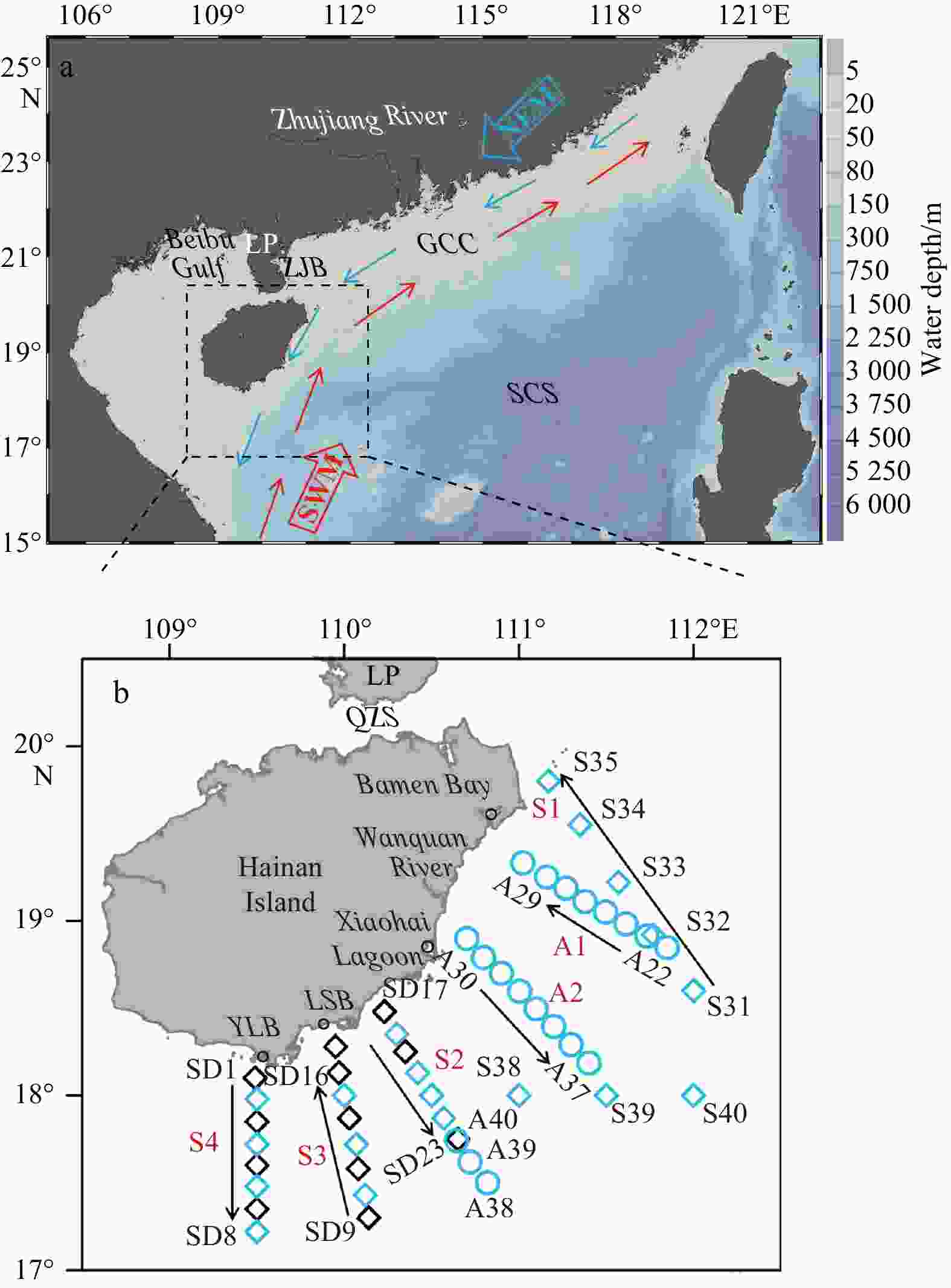
 下载:
下载:
